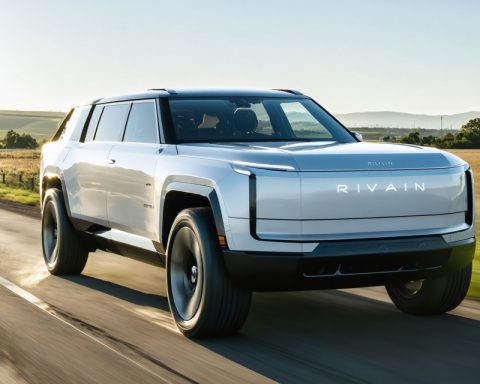- Rivian reports a significant milestone by achieving positive gross profit, marking its financial stabilization.
- Cost reduction per vehicle by $31,000 positions Rivian as a formidable contender in the EV market.
- The upcoming R2 SUV, priced at $45,000, is aimed at a larger market, reflecting a strategy similar to Tesla’s Model Y.
- Rivian’s cash reserves have grown to $7.7 billion, supported by strategic partnerships like the one with Volkswagen.
- Innovative developments include Rivian’s Autonomy Platform, paving the way for advanced driving technology.
- Although 2025 production forecasts face challenges, reduced operational losses hint at continued growth and adaptation.
- Rivian’s strategies promise a strong future characterized by innovation and sustainability as 2026 approaches.
Rivian, the burgeoning force in the electric vehicle (EV) sector, finds itself at a thrilling juncture as it reports a significant triumph in its latest quarterly earnings. The once cash-burning contender has finally crossed into positive gross profit territory, heralding a new era of financial stability. By slashing costs by a staggering $31,000 per vehicle, Rivian has poised itself as an emerging giant, inviting investors to ride along its promising path.
The launch of the R2 SUV, set for 2026, embodies Rivian’s audacious vision. With a price tag of $45,000, it aims to capture a market thrice the size of its premium predecessors. The upcoming model echoes the strategic boldness reminiscent of Tesla’s game-changing Model Y launch. This midsize SUV represents not just a vehicle but a gateway to a broader audience eager for affordable yet high-performance EVs.
Bolstering this ambitious expansion is Rivian’s fortified cash reserves, swelling to $7.7 billion. Strategic alliances, such as its collaboration with Volkswagen, amplify this financial robustness, setting the stage for a ramp-up in production without the worry of running dry. Further enhancing its innovative edge, Rivian’s sophisticated Autonomy Platform is edging closer to reality, promising both hands-free and, eventually, eyes-off driving experiences.
While the 2025 production forecast may seem timid, marred by unforeseen obstacles like natural disasters, the shrinking operational losses hint at brighter horizons. Rivian isn’t just adapting; it’s evolving. This year might be a mere speed bump, but its strategic maneuvers today promise a cascade of successes as 2026 approaches. Investors attuned to Rivian’s trajectory may find themselves accelerating into an era defined by growth, innovation, and sustainability.
Rivian’s Road to Dominance: How This EV Pioneer is Shaping the Future
How-To Steps & Life Hacks
To gain insights into Rivian’s success and how you can apply similar strategies to your investments or business, consider these steps:
1. Cost Management: Rivian significantly reduced costs by $31,000 per vehicle. Learn from this by auditing your own expenses and identifying areas where costs can be cut without sacrificing quality.
2. Strategic Partnerships: Collaborating with established brands like Volkswagen can leverage collective strengths. Seek partnerships that complement your offerings or fill gaps in your capabilities.
3. Innovation: Rivian’s ambitious Autonomy Platform illustrates the importance of investing in R&D. Stay ahead by continually innovating your product offerings.
Real-World Use Cases
Rivian is targeting a broader market with its R2 SUV, intended to cater not only to eco-conscious consumers but also to middle-income families looking for affordable EV options. This model could become a popular choice for:
– Suburban Families: Needing reliable, spacious transportation.
– Urban Commuters: Seeking sustainable solutions for daily commutes.
– Fleet Operators: Interested in transitioning to electric models to reduce carbon footprints.
Market Forecasts & Industry Trends
The EV market is expected to grow significantly, with BloombergNEF projecting that by 2040, over half of all passenger vehicles sold will be electric. Rivian’s strategic entry into more affordable EV segments aligns with industry trends showing growing consumer demand for lower-cost electric options.
Reviews & Comparisons
While Rivian has been compared to Tesla due to its innovative approach and ambitious vision, it differentiates itself with a more rugged, adventure-oriented brand image. Its vehicles have been lauded for their performance and design, often compared favorably to similarly priced models from other manufacturers.
Controversies & Limitations
While Rivian is making impressive strides, the company faces challenges such as production delays and potential supply chain disruptions. Moreover, achieving full autonomy in driving technology presents significant regulatory and technological hurdles.
Features, Specs & Pricing
Rivian’s R2 SUV is expected to feature:
– Price: Approximately $45,000
– Range: Competitive mileage aimed at satisfying daily and long-distance travel needs
– Autonomy: Cutting-edge autonomy with future advancements planned
Security & Sustainability
Rivian’s focus on sustainability is evident not just in their EV offerings but also in their operational strategies, including the use of recycled materials. Security in their autonomy platform is also a priority, aiming to ensure data privacy and system reliability.
Insights & Predictions
Analysts predict that Rivian’s growth trajectory will be robust, especially with a move into more affordable vehicle categories. Their financial strategy, including strengthening cash reserves, situates them well to weather economic fluctuations and invest in future developments.
Tutorials & Compatibility
To maximize your experience with Rivian vehicles, it’s advisable to access tutorials provided by the company on vehicle features and maintenance to ensure optimal performance and longevity.
Pros & Cons Overview
Pros:
– Entry into affordable EV market segments
– Strong financial positioning
– Innovative autonomy technology
Cons:
– Production challenges
– Regulatory hurdles for full autonomy
Actionable Recommendations
– Investors should watch Rivian’s financial strategies and expansion plans closely, considering their robust cash reserves and strategic partnerships as indicators of future growth.
– Consumers interested in EVs could consider upcoming models like the R2 SUV as attainable options combining affordability with innovative features.
– Business Leaders can take a page from Rivian’s playbook by emphasizing cost management, strategic partnerships, and continual innovation to drive growth.
For more on Rivian and their journey in the EV market, visit Rivian. Stay informed about the latest industry trends and strategic insights that could impact your future transportation options.









